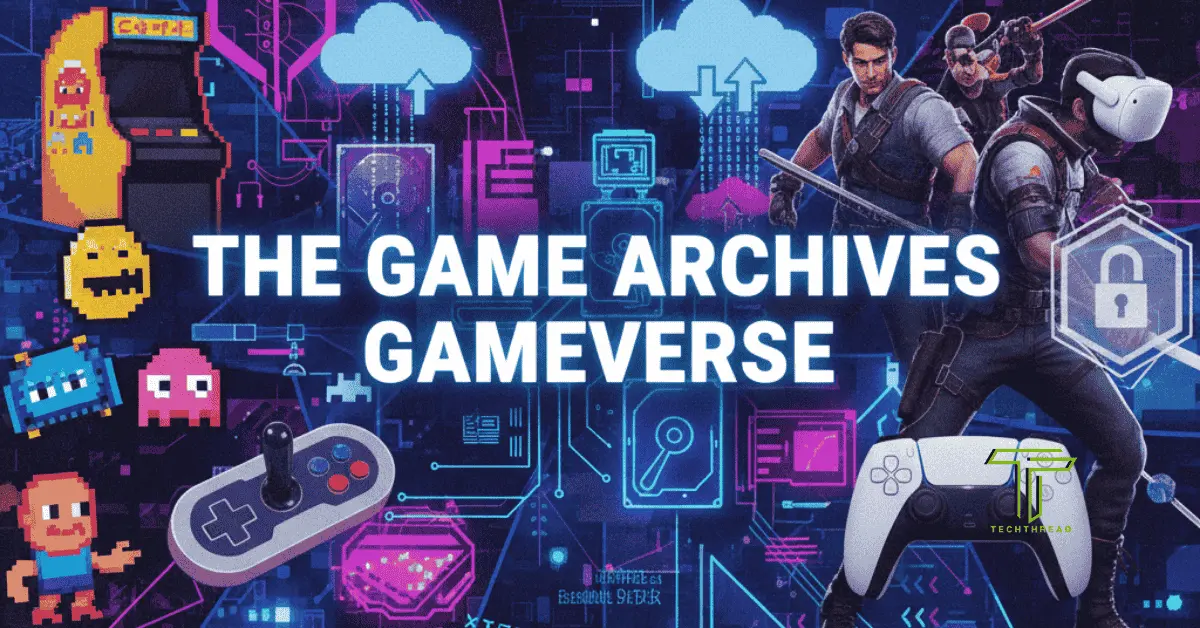The Game Archives Gameverse: Preserving the Legacy of Digital Gaming
Today’s video games are tomorrow’s cultural artifacts. But with the rapid pace of technology, many iconic games risk disappearing forever. This is the problem The Game Archives Gameverse aims to solve.
In this blog, we’ll explore what the Gameverse is, why preserving gaming history matters, and how you can be part of this mission.
We’ll uncover its key features, its cultural role, and how emerging technologies are shaping the future of digital game preservation. Get ready to see gaming in a whole new light.
Table of Contents
What Exactly is The Game Archives Gameverse?
The Game Archives Gameverse is a digital archive built to preserve, document, and celebrate video games across all eras and genres. Unlike casual fan lists, this archive aims to catalog every game’s historical importance, development story, and cultural footprint.
It offers detailed profiles of games from vintage arcade hits to modern indie releases. Beyond storing games, the Gameverse serves as a bridge between players, historians, and developers. Each entry provides context — who made it, why it mattered, and how it influenced gaming trends. This approach helps ensure that every contribution to video game history is recognized, from the most famous franchises to forgotten gems.
By making its resources free and interactive, the platform invites everyone to participate in preserving the rich tapestry of digital gaming heritage. It’s not just an archive — it’s a living museum for gamers.
Why Preserving Video Games is Critical for Culture and Innovation
Games aren’t just entertainment; they are historical documents of creativity, technology, and culture.
Without deliberate digital game preservation, countless influential works could vanish forever. Unlike books or films, games depend heavily on fragile hardware that wears out or becomes obsolete.
Early consoles like the Atari 2600 and Sega Saturn already face major preservation challenges due to aging components.
Moreover, online games face an even bigger threat — server shutdowns. Once a game’s online world closes, there’s often no way to experience it again. By archiving not just the software but also manuals, box art, interviews, and fan stories, platforms like The Game Archives Gameverse safeguard an entire ecosystem of memories and cultural evolution.
Preservation also supports innovation. Developers studying past design trends find inspiration for new ideas. In short, protecting gaming history ensures that future generations can learn, create, and play without losing touch with where it all began.
Gaming and Culture: Understanding the Global Impact of Video Games
Video games have become one of the world’s most influential cultural forces. From political commentary in Papers, Please to social change movements inside Animal Crossing, games mirror the world around us. They reflect issues of race, gender, economics, and identity, providing a medium where players explore and confront real-world challenges.
The Game Archives Gameverse highlights this cultural significance by documenting how games shape, and are shaped by, global events. For instance, Cold War-era games often featured aliens or enemies from afar, mirroring political anxieties of the time. Modern open-world games like The Last of Us Part II dive into complex moral dilemmas rarely seen in other entertainment forms.
Understanding gaming’s cultural footprint is impossible without preserving it. Thanks to archives like the Gameverse, researchers and fans can trace how gaming has evolved alongside major global shifts, enriching our view of both gaming and history.
A Brief History of Video Games: From Pixels to Virtual Worlds
The journey of gaming began humbly with simple block-based graphics and has evolved into complex, cinematic universes. Titles like Pong (1972) introduced interactive entertainment to a mass audience, while games like Super Mario Bros (1985) set the foundation for platformers still loved today.
In the 1990s, 3D gaming revolutionized design with hits like Doom and The Legend of Zelda: Ocarina of Time. The 2000s brought the online multiplayer boom, with games like World of Warcraft shaping social gaming experiences. Today’s games leverage powerful AI, photorealistic graphics, and massive open worlds.
The Game Archives Gameverse carefully traces this progression, offering users a timeline of important milestones. By connecting historical context to technological innovations, the archive not only preserves memories but also educates users on how far gaming has come — and where it’s heading.
Key Features that Make The Game Archives Gameverse Unique
The strength of The Game Archives Gameverse lies in its depth and variety.
Key features include:
- Comprehensive Game Listings:
Games are organized with detailed metadata, including developers, platforms, genres, release dates, and critical reception. - In-Depth Analyses and Reviews:
Each featured title includes expert analyses that explain why it mattered historically and culturally. - Community Contributions:
Members of the gaming community can submit memories, missing data, and rare materials, making the archive a living, breathing project. - Interactive Tools:
Virtual exhibits, game timelines, and playable demos engage users beyond static pages. - Educational Resources:
Perfect for students, historians, and developers looking to study the evolution of gaming.
By offering both factual documentation and personal stories, the Game Archives Gameverse ensures that the full richness of gaming culture is preserved and accessible to all.
How Comprehensive Game Listings Help Researchers and Players
Every game listed in The Game Archives Gameverse includes critical information needed for academic study or fan enjoyment.
Listings feature:
- Screenshots and gameplay videos
- Technical details (engine, coding language, file sizes)
- Developer interviews and design notes
- Cultural impact assessments
For example, a listing on Metal Gear Solid explains not only its gameplay but its influence on stealth mechanics across the industry.
Researchers can trace genre evolution, while casual players can rediscover hidden gems.
This depth transforms the archive into both a research tool and a playground for curious minds.
Why In-Depth Analyses Matter for Understanding Gaming History
Facts alone don’t capture the full picture of gaming history. The Game Archives Gameverse provides in-depth essays exploring how and why games left their mark.
These analyses consider:
- Storytelling innovations
- Technical achievements
- Societal impact
For instance, an article about The Sims explores how it changed simulation gaming and influenced real-world ideas about design and relationships.
By pairing hard data with thoughtful commentary, the archive ensures that visitors don’t just know when a game launched — they understand why it mattered.
Community Contributions: Building a Collective Gaming Memory
Gaming memories are personal. That’s why The Game Archives Gameverse invites players, developers, and historians to add their voices.
Community contributions include:
- Personal stories and gameplay memories
- Rare promotional materials
- Missing games or corrections
For example, a user might upload an obscure Japanese-only release, helping researchers expand global gaming history.
This inclusive approach means that the archive reflects a richer, more diverse history than any one organization could build alone.
It turns the archive into a collective memory — one that grows stronger with every contribution.
How to Navigate and Experience The Game Archives Gameverse
Getting the most out of The Game Archives Gameverse is easy.
Features include:
- A fast search tool sorted by genre, era, platform
- Curated collections like “Top Arcade Hits” or “Hidden Indie Gems”
- Timeline views showing gaming’s evolution year-by-year
- Interactive community forums
Whether you’re a veteran gamer or new to gaming history, the platform’s user-friendly design makes exploration simple and fun.
You can quickly dive into curated collections or take your time browsing through different decades of gaming development.
Interactive Experiences: Play, Learn, and Connect
Learning about gaming history shouldn’t be passive. The Game Archives Gameverse brings history to life with:
- Playable browser demos of classic games
- Virtual museum exhibits
- Interactive historical timelines
Imagine exploring a 1980s arcade from your living room, complete with virtual cabinets and original artwork. Or playing a demo of a lost prototype game thought to be gone forever. These interactive elements help users connect emotionally and intellectually with gaming’s rich past.
Events, Collaborations, and the Growing Impact of Gaming Archives
The Game Archives Gameverse doesn’t just store history; it celebrates it.
Events and partnerships include:
- Retro gaming festivals streamed online
- Collaborations with tech museums and universities
- Guest speakers like legendary game developers and historians
For example, a recent virtual event showcased rare behind-the-scenes footage from the development of Street Fighter II. These collaborations help bridge the gap between academia, developers, and the gaming public, ensuring that preservation efforts reach the widest possible audience.
The Future of The Game Archives Gameverse
The next era of The Game Archives Gameverse is all about scalability and security. Cloud storage will ensure backups survive hardware failures. Blockchain could be used to verify the authenticity of rare finds and protect against digital decay. Artificial intelligence will help catalog games faster, identifying missing metadata automatically.
Perhaps most importantly, expanding global community contributions will help document underrepresented regions and gaming cultures. By combining emerging technologies with passionate player input, the archive is positioned to remain a permanent part of the gaming world’s future.
How Emerging Technologies Will Future-Proof Game Preservation
New tools will make preserving games easier and more reliable than ever.
Key advancements include:
- Blockchain Authentication:
Ensures that archived versions of games are genuine, untouched copies. - Cloud-Based Redundancy:
Multiple backups prevent loss due to disasters. - AI Metadata Tagging:
Speeds up the cataloging of large gaming libraries by automating tedious processes. - Virtual Reality Archives:
Immersive VR experiences could one day let players “walk” through entire decades of gaming history.
By embracing these technologies, The Game Archives Gameverse will remain accessible to future gamers, researchers, and creators alike.
Conclusion: Join the Movement to Preserve Gaming’s Legacy
The Game Archives Gameverse proves that video games are much more than a pastime — they are art, culture, and history. By protecting this legacy, we ensure that tomorrow’s players, developers, and historians can learn from and celebrate gaming’s rich heritage. The journey doesn’t end with the archive team; it belongs to all of us. Whether you contribute a rare game, share your stories, or simply explore the collections, you are helping keep gaming history alive. Visit The Game Archives Gameverse today and become a guardian of digital culture.
Frequently Asked Questions (FAQs)
Q1: What is the main purpose of The Game Archives Gameverse?
The Game Archives Gameverse is a digital archive dedicated to preserving, documenting, and celebrating video games from all eras and genres. Its main purpose is to ensure that the historical importance, development stories, and cultural footprint of iconic games do not disappear, serving as a living museum for gaming history.
Q2: Why is digital game preservation so critical, especially for older games?
Preserving video games is critical because they are valuable cultural artifacts that reflect technology, creativity, and societal trends. Unlike other media, games rely on fragile hardware that becomes obsolete, and online-only games risk vanishing entirely due to server shutdowns. Preservation safeguards these works, ensuring future generations can learn from and enjoy gaming’s rich history.
Q3: How does The Game Archives Gameverse engage the community in its mission?
The Game Archives Gameverse is designed to be interactive and community-driven. It invites players, developers, and historians to contribute personal stories, rare materials, missing data, and corrections. This collaborative approach enriches the archive and ensures it reflects a diverse and collective gaming memory.
Q4: What role do emerging technologies like AI, Blockchain, and Cloud play in the Gameverse’s future?
Emerging technologies are crucial for future-proofing game preservation. Cloud storage ensures redundancy and data integrity, while Blockchain can verify the authenticity of archived games. AI helps automate metadata tagging and cataloging, making the archive more efficient and scalable. These technologies enhance security, accessibility, and the overall robustness of the preservation efforts.
Q5: Beyond archiving games, how does the Gameverse help us understand gaming’s cultural impact?
The Gameverse goes beyond just storing games by offering in-depth analyses, educational resources, and documentation of how games reflect and influence global culture. It highlights political commentary, social change movements, and how games explore themes of identity, economics, and moral dilemmas, allowing researchers and fans to trace gaming’s evolution alongside major societal shifts.
Also Read: iCostamp Technology Explained: Smarter Monitoring for Supply Chains







